From Chaos to Control: Master Time Management with Ease

Time Management
Have you ever found yourself struggling with time, wondering where the hours disappeared? Maybe you had the best intentions to tackle your to-do list but ended up binge-watching a series or scrolling through your phone instead. Trust me, I’ve been there. The truth is, time management isn’t about turning into a scheduling robot or squeezing every minute out of your day – it’s about finding a balance that works for you.
But before you assume I’m here to throw some generic advice your way (you know, the usual “get up at 5 a.m. and meditate for an hour”), let’s get real. This blog is about practical techniques that you can apply without becoming a productivity robot. Because, honestly, who’s got the time for that?
Before we dive into how you can conquer time, let’s talk about why it sometimes feels so elusive in the first place.
Why Do People Struggle with Time Management?
Time management isn’t as straightforward as plugging a schedule into your day. There are several reasons why it can feel like you’re always running behind:
- Procrastination – The dreaded P-word. Sometimes, putting things off just feels easier, but it adds up quickly. Let’s say you’ve got a big report due in a week. Instead of starting it early, you find yourself cleaning the house, checking Instagram, and telling yourself, “I’ll get to it later.” And before you know it, your deadlines are looming, and panic sets in.
- Lack of Prioritization – Ever been caught in the “I have so much to do, I don’t know where to start” loop? I’ve definitely been there. I’d begin my day by randomly tackling tasks as they came in. By 5 p.m., I’d look at my to-do list and realize the most important things hadn’t even been touched. Oops!!
When everything on your list feels equally important, it’s hard to know where to start. This can lead to jumping between tasks without actually finishing anything. - Distractions – Picture this: You sit down to focus, but your phone dings, an email pops up, or you remember that funny YouTube video your colleague mentioned. Distractions, even small ones, can add up and steal away hours of your day.
- Overcommitting – There was a time when I said “yes” to too many initiatives. Between client meetings, presentations, and multiple projects, I thought I could juggle it all. But soon, I found myself constantly behind, rushing from one thing to the next, and not giving any task the attention it deserved.
Saying “yes” to everything might make you feel productive at first, but it usually results in an overwhelming schedule and not enough time for the things that matter. It was a good lesson in learning that sometimes, saying “no” is just as important as saying “yes”. - Perfectionism – I’ve definitely fallen into the perfectionism trap. I once spent hours fine-tuning a presentation – adjusting slides, tweaking fonts, reworking images—until I realized I had spent way more time than necessary on minor details. The presentation turned out great, but in hindsight, I could’ve wrapped it up much sooner and focused on other important tasks.
The desire to get things just right can slow you down. Instead of making progress, you end up spending too much time on one task. Lesson learned: sometimes good enough is exactly what you need. - Multitasking – We all think we’re good at multitasking, but truth be told, it’s not as efficient as we’d like to believe. I once tried answering emails, attending a Zoom meeting, and working on a project all at once. The result? I barely absorbed anything from the meeting and had to redo half of my work later. Lesson learned—multitasking isn’t as effective as it sounds. Constantly switching between tasks can make it hard to focus and reduce productivity.
Time to Take Control
Now that we’ve uncovered some of the common pitfalls, it’s time to turn the tables. Below, I’ve shared some tried-and-true techniques to help manage your time more effectively without losing your sanity. You’ll find that with a little structure (and a lot of flexibility), managing time can be less stressful and even a bit fun!
1. The Pomodoro Technique (A.K.A. Get Stuff Done in Bite-Sized Chunks)
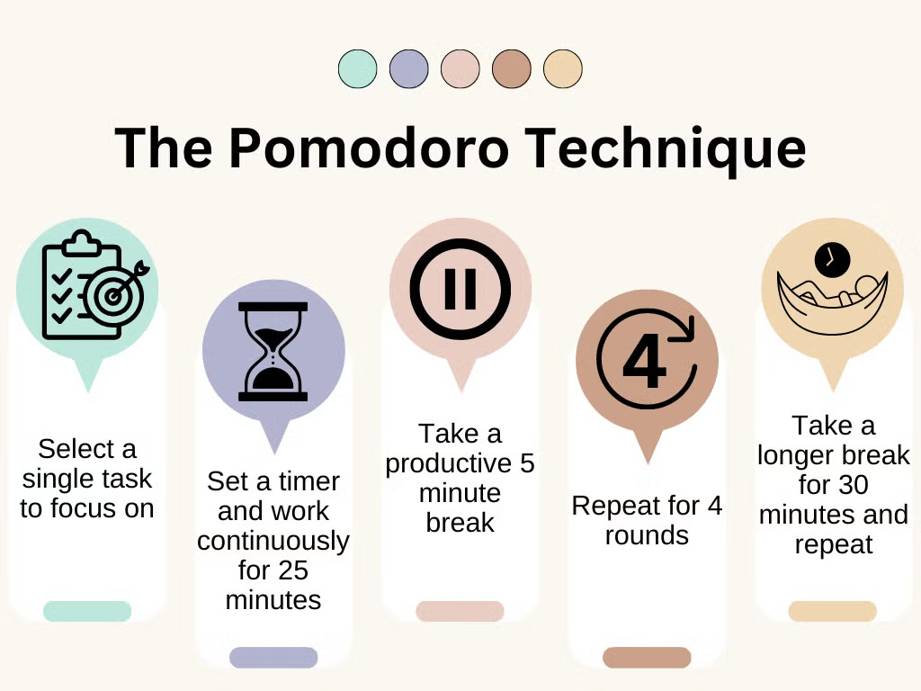
The Pomodoro Technique
The idea here is simple: break your work into 25-minute focused sessions (called “Pomodoros”) with a 5-minute break in between. After four Pomodoros, reward yourself with a longer break – say, 15-30 minutes.
Let’s say you’ve got a huge research paper to write. Instead of trying to work on it for hours, set a timer for 25 minutes and focus. When the timer goes off, take a 5-minute break. After four of these sessions, take a longer break. You’ll feel refreshed and keep your energy up. I used this when preparing for a big client presentation—it made the work seem way less overwhelming.
It’s surprisingly effective for avoiding burnout. Plus, it gives you an excuse to step away for a coffee or a quick stretch, which we all need more of!
2. Time Blocking: Your Day’s Personal Tetris
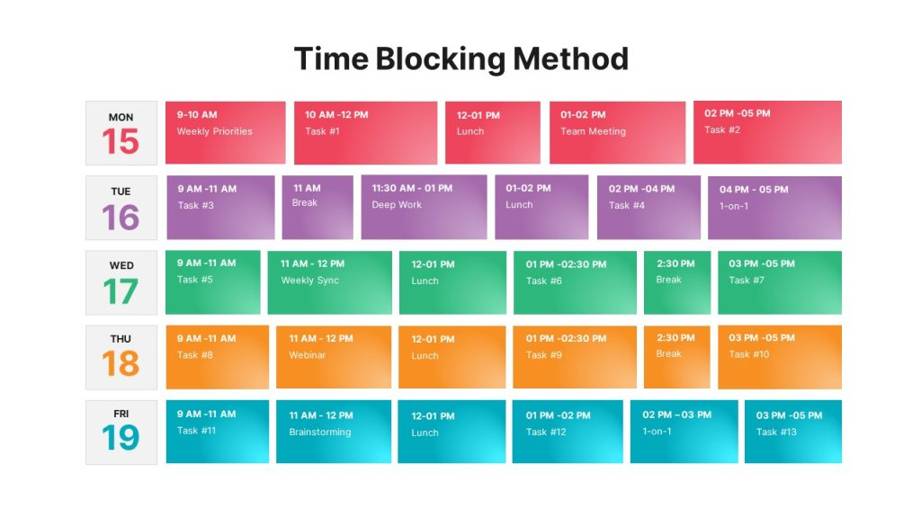
Time Blocking
Ever feel like the day just slips away before you get half of what you want to do? That’s where time blocking comes to the rescue. In this technique, you divide your day into blocks of time dedicated to specific tasks. Want to answer emails? Block 10-11 a.m. Need deep focus on that new project? Block 1-3 p.m. Think of your calendar as a puzzle you’re putting together, ensuring every important piece fits into your day.
The beauty? No more wondering what to do next. Just check your calendar, and bam, you’re on track.
3. Eat the Frog (Yes, It’s Weird, but It Works)
No, I’m not suggesting you actually eat a frog, but metaphorically speaking, this technique is a gem. The idea is to tackle your hardest, most dreaded task first thing in the morning. Once that “frog” is out of the way, the rest of the day feels like smooth sailing.
Preparing weekly status reports for multiple teams always felt like a chore I wanted to push to the end of the day. But once I decided to tackle them first thing in the morning, I felt a huge weight lifted off my shoulders. With that out of the way, I could focus on more exciting tasks.
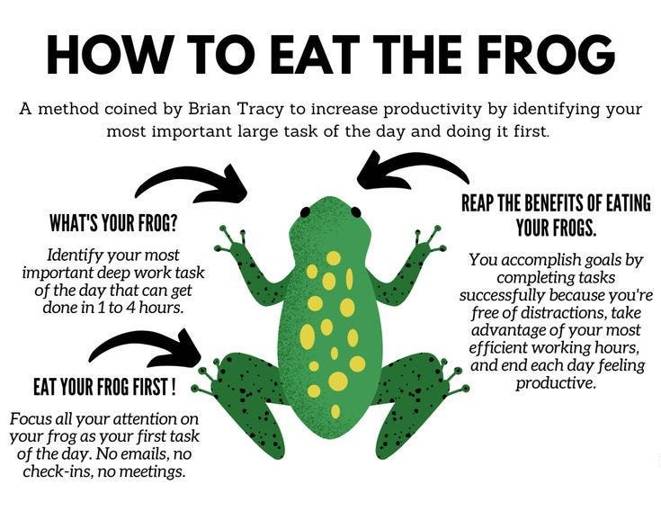
Eat The Frog Method
4. Batching Tasks: Multitasking’s Cool Cousin
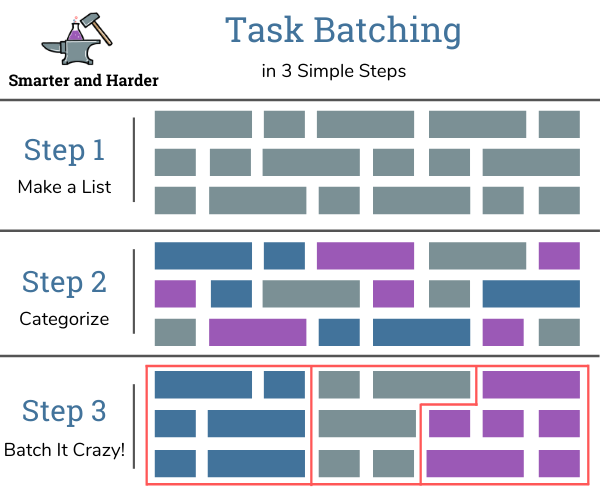
Task Batching
If you find yourself constantly switching between different kinds of tasks (emails, calls, actual work), batching is a game-changer. Group similar tasks together and dedicate chunks of time to knock them out. For example, set aside 30 minutes just for answering emails, and another hour for focused project work. Bouncing between unrelated tasks eats up time, and batching helps eliminate that back-and-forth brain drain.
5. Parkinson’s Law: Keep It Short and Sweet
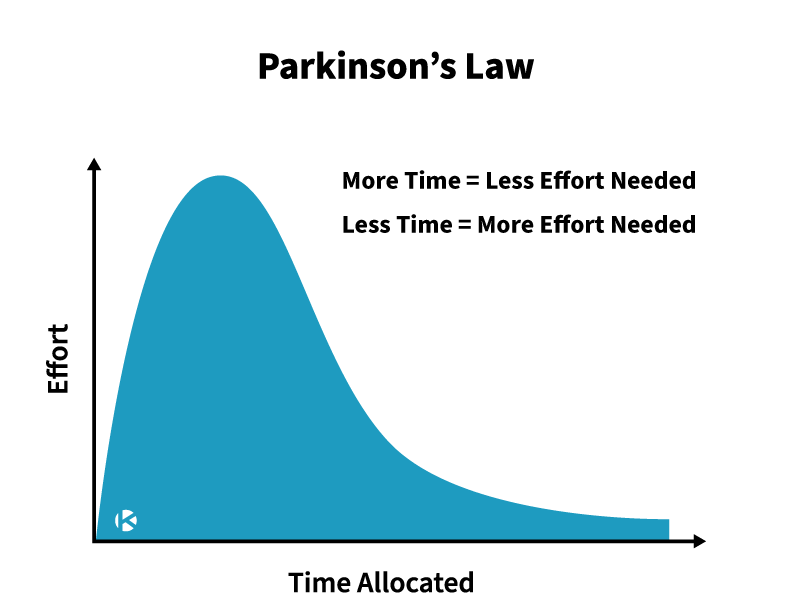
Parkinson’s Law
Parkinson’s Law states that “work expands to fill the time available for its completion.” Translation? If you give yourself two hours to complete a task, it’ll probably take two hours. But if you challenge yourself to finish it in 45 minutes, you’ll be surprised at how much faster you can get it done. Set shorter deadlines for your tasks, and watch yourself become a productivity ninja.
6. The 80/20 Rule (Pareto Principle): Focus on What Matters
This one’s simple: 80% of your results come from 20% of your efforts. So, instead of trying to do everything, focus on the tasks that actually drive results.
At one point, I realized I was spending way too much time on small, low-impact tasks—like tweaking internal documents or attending non-critical meetings. After applying the 80/20 rule, I shifted my focus to the 20% of tasks that would drive the biggest results, like preparing high-impact client presentations and working on strategic initiatives. It was a game-changer. Not only did I get more done, but the work I was doing had a much bigger impact on my overall goals.
So next time ask yourself, “What’s going to make the biggest impact today?” Prioritize those, and you’ll get more done with less effort.
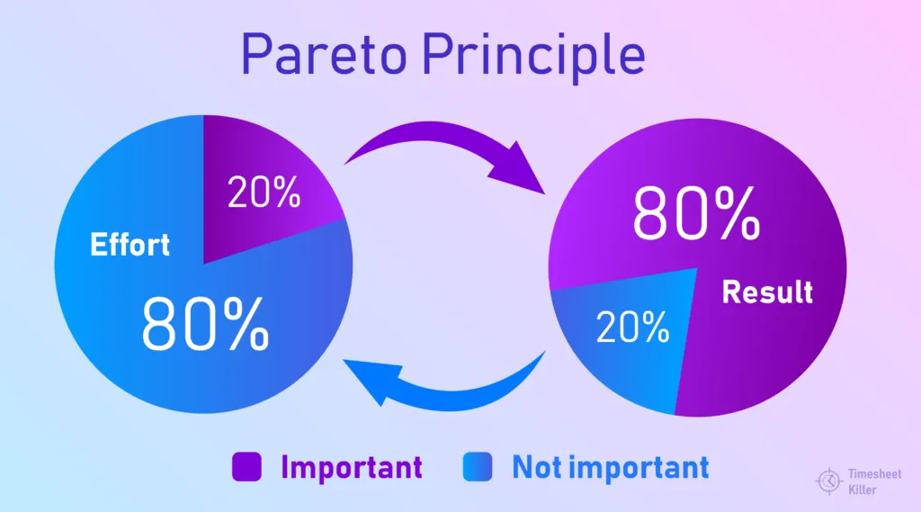
Pareto Principle
7. The Two-Minute Rule: Quick Wins Are Still Wins
If a task can be done in under two minutes, just do it now. Whether it’s sending that quick reply or tidying up your workspace, knocking out these little tasks keeps things moving, and they don’t pile up into overwhelming clutter.
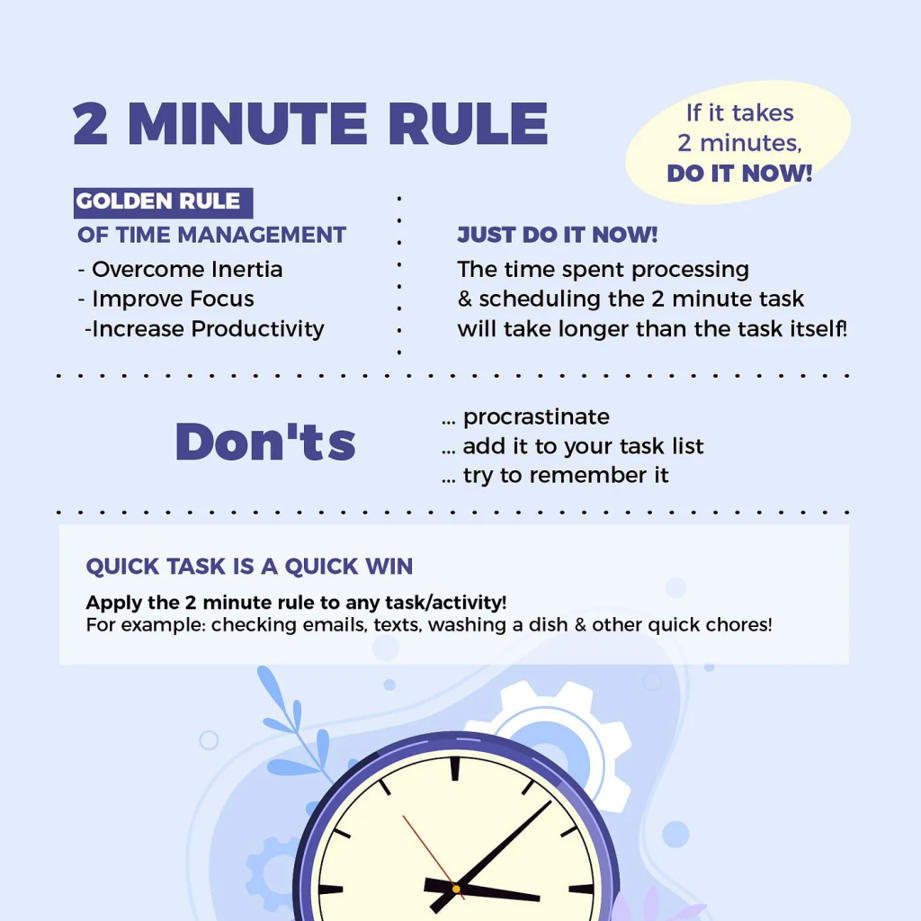
2 Minute Rule
Time Management Doesn’t Have to Be a Chore
Time management is more about working smart than working hard. Instead of trying to squeeze every second out of the day, the goal is to find balance – and maybe even have fun while you’re at it! With these techniques in your back pocket, you’ll find that managing your time is less about sticking to rigid schedules and more about creating a rhythm that works for you.
Now, go block out some time for a break – you’ve earned it!

